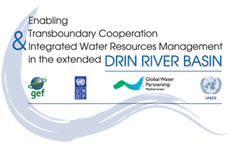Lake Skadar/Shkoder
Hydrology and hydrogeology
The lake discharges through the 44 km long Buna/Bojana River (shared by Albania and Montenegro) into the Adriatic Sea. The connection between Drin River, Buna/Bojana River and Skadar/ Shkoder Lake determines the seasonal variations in the state and characteristics of the lake, as well as the Buna/Bojana and the tributaries in their catchment area, and has an important impact on the morphology of the Buna/Bojana delta. The hydrological regime is conditioned, among others, by water releases from big hydro-power dams in the Drin River in Albania.
The Buna/Bojana bed is lower than sea level (“crypto depression”), resulting in saltwater intruding into the lake’s outlet.
Pressures, status, transboundary impacts and responses
In the Montenegrin part, arable land makes up 40%, and pastures 10% of the basin. In the Albanian part, 13% of the land is used for agricultural activities, while 64% is forests, pastures and abandoned land.
Agricultural as well as industrial pollution (heavy industries in the Montenegrin side are also significant water consumers), and pollution from municipal wastewater, reach the lake both through surface and groundwater (due to the karstic geology). Due to the nutrient loading, the lake has eutrophied slightly. Inadequate solid waste management in both countries and illegal disposal of wastes directly to the water bodies has exerted pressure on the lake’s system. Wastewater collection and treatment facilities that are currently being constructed in the Albanian side, the reconstruction of existing facilities in Montenegro (in Podgorica), as well as the construction of solid waste management facilities in both countries, are expected to improve the situation. Heavy metal pollution, especially in lake sediments, and moderate pathogen loads have been observed locally in the aquifer. The Drin contributes to some extent, with trace metals originating from the disposal of by-products from iron and copper mines located upstream.
Unsustainable forest management in the Albanian side and subsequent erosion as well as illegal construction, has led to the deterioration of shoreline habitats.
In general, the quality of the lake’s water is considered to be reasonably good, due to the high renewal rate (2-3 times per year), the inaccessibility of the higher parts of the catchment, and the sharp reduction in inflowing industrial effluents and agricultural run-off. The Buna/Bojana’s water quality also seems to be in the same generally good condition.
Total biodiversity is high, and the region is considered to be a biogenetic reserve of European importance. The large, geographically and ecologically connected complex system of wetlands of Skadar/Shkoder Lake and the Buna/Bojana River has been identified as one of the 24 transboundary wetland sites of international importance known as “Ecological Brick Sites”.
Lake Skadar/Shkoder and the Buna/Bojana basin still need attention and measures to protect the state of this unique ecosystem. The two countries are taking action in this regard. Almost the whole of the Lake Skadar/Shkoder and Buna/Bojana River area is under national protection status. Regarding consolidation and harmonization of management of the protected areas, Montenegro is more advanced, and harmonization of measures across borders would be beneficial.
Transboundary cooperation
The Agreement between Albania and Montenegro for the Protection and Sustainable Development of the Skadar/Shkoder Lake, signed in 2008, was the latest legal document on cooperation on environmental management issues. This Agreement serves, among others, as the legal instrument for the implementation of the joint Strategic Action Plan for the lake, agreed between the two Governments. The Skadar/Shkoder Lake Commission has been established under the Agreement, and commenced work in 2009. A Joint Secretariat is based in Shkodra, Albania, and four Working Groups (Planning and Legal; Monitoring and Research; Communication/Outreach and Sustainable Tourism; and Water Management) provide support.
Action and coordination at national level need to accompany transboundary cooperation, which is mostly supported by the GEF project (main activities initiated in 2008). Harmonization of management approaches and instruments is an imperative in the long term. The establishment of a sustainable fishery strategy and further action for pollution reduction and prevention are among the priorities. Detailed hydrogeological mapping and investigation of the relationships between karst groundwater and groundwater of the alluvial deposits with Skadar/Shkoder Lake (through the development of the Lake watershed area hydrological model), monitoring of surface and groundwater, water demand management measures, groundwater abstraction control, vulnerability mapping for land use planning, and protection zones for drinking water supply also need to be applied, established or improved.
Trends
A well-defined pollution trend cannot be established for the lake, due to the lack of continuous data; water quality seems to have been varying in space and time.
Tourism is considered to be a major economic driver in both parts of the basin. Moreover, four dams are planned for construction in the Morača – the main tributary of Skadar/Shkoder Lake, flowing through Montenegro. The project has been anticipated in the Spatial Plan of Montenegro.
The impacts on the lakes-rivers-wetlands-groundwater system of the current economic development proposals and plans in both countries that involve alternative uses of water and the water bodies need to be clearly understood, before any decision is taken.
Transboundary cooperation in the “extended” Drin Basin
The Drin Basin needs to be managed as an entity to ensure effective and sustainable management of water and ecosystems. Although there is an established cooperation between the riparian countries in the sub-basins of Prespa, Ohrid and Skadar/Shkoder Lakes, there is no such cooperation at the “extended” Drin Basin level. Albania, the former Yugoslav Republic of Macedonia, Greece, and the European Commission signed an agreement on the protection and sustainable development of the Prespa Park Area in February 2010. The Petersberg Phase II/Athens Declaration Process (coordinated by Germany, Greece and the World Bank, supported technically and administratively by GWPMed), acting in cooperation with UNECE, GEF and UNDP, facilitates a regional multi-stakeholder dialogue process, aiming to explore possibilities of moving the level of cooperation from the sub-basin to the Drin Basin level.
Read more about Lake Skadar/Shkoder and River Buna/Bojana Ramsar Sites





